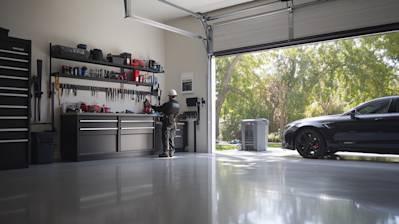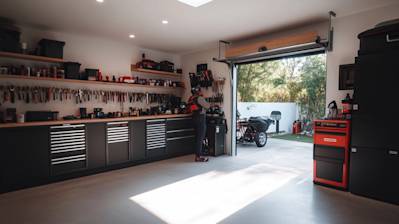Garage door torsion springs are crucial components in the smooth function of your garage door system - they play a significant role in the open-and-shut mechanism. They are designed to counterbalance the weight of the garage door, which makes it easier for you or your garage door opener to lift and lower the door.
Torsion Springs Vs. Extension Springs
Garage doors use either torsion springs or extension springs. Torsion springs, mounted above the garage door opening, use torque to lift the door. When the garage door goes up, the springs unwind and the stored tension lifts the door. Extension springs, located on both sides of the door, stretch and contract to achieve the same goal.
The main advantages of torsion springs are their durability, safety, and better balance. While extension springs can act as a projectile if it snaps, a torsion spring, due to its design, will stay put even if it breaks.
How Garage Door Torsion Springs Work
The garage door torsion spring is mounted horizontally above the garage door. When the door is shut, the spring is tightly wound, storing energy. When the door is opened, the spring unwinds, releasing its stored energy to lift the door. A central shaft runs through the spring, ensuring it is secure and evenly distributes the door's weight when lifting.
Recognizing Faulty Garage Door Torsion Springs
Several signs can indicate a malfunctioning torsion spring:
- Difficulty in opening the garage door
- An unusually heavy garage door
- The door drops rapidly when lowering
- The door lifts only a few inches and then stops
- Visible gaps in the spring
- Banging or snapping noises
Safety Measures When Handling Torsion Springs
Garage door torsion springs store a high amount of energy, which could cause injury if not appropriately managed. Therefore, unless you have professional training and the right tools, it's best to contact experts for garage door torsion spring repair or replacement.
Additionally, never:
- Remove or adjust the bottom brackets on your own as they are under high tension
- Touch the spring with any tool or object unless you're a qualified technician
Choosing the Right Torsion Spring
The garage door torsion springs' lifespan largely depends on their cycle rating, with one cycle representing the spring's ability to lift the garage door once and bring it back down. Common categories include:
- 10,000-cycle springs, suitable for residences with a single car garage
- 20,000-cycle springs, for garages used more often
- High-cycle springs, with a lifespan of over 50,000 cycles, beneficial for commercial or heavy-duty application
When selecting a replacement spring, choose one matching your current spring's size and weight capacity. The factors determining spring size include:
- The Door Height: Standard residential garage doors often need torsion springs designed for 7-8 feet height.
- The Door Width: Single car garage doors typically use one spring, while double car doors use two.
- The Door Weight: This affects the torsion spring's size and tension. More robust springs are needed for heavier doors.
Frequently Asked Questions about Garage Door Torsion Springs
What types of garage door torsion springs are there?
There are primarily two types of garage door torsion springs - standard torsion springs and torque master torsion springs. Standard torsion springs are mounted on a stationary metal shaft above the garage door, while torque master springs are located inside the torsion rod.
How can I determine the right size of garage door torsion springs?
Choosing the right size of garage door torsion springs is critical. You can determine the right size by measuring the length of the spring when it's unwound or relaxed. You should also note the inside diameter and the wire size, all of which are necessary for ordering the correct replacement.
How often should garage door torsion springs be replaced?
The lifespan of garage door torsion springs is typically measured in cycles, with one cycle being the garage door opening and closing once. Standard springs have a lifespan of about 10,000 cycles. Depending on how often you use your garage, torsion springs should generally be replaced every 7 to 9 years.
Can I replace the garage door torsion springs myself?
While it's possible to replace garage door torsion springs yourself, it isn't recommended unless you have the right tools and a comprehensive understanding of the procedure. Replacing torsion springs can be dangerous because they're under high tension, and a simple mistake can lead to severe injuries.
Should I replace both torsion springs if one breaks?
It's advisable to replace both garage door torsion springs if one of them breaks. This is because both springs are usually installed at the same time, meaning they likely have the same amount of wear and tear.
What safety measures should I take when working with garage door torsion springs?
When working with garage door torsion springs, it's important to take safety precautions. Always wear safety goggles and heavy-duty work gloves to protect your eyes and hands. Also, be sure not to place your fingers between the springs and use the right tools when adjusting or replacing them.
Pros of Garage Door Torsion Springs
High Durability
Long Lifespan
One of the major advantages of garage door torsion springs is their known lifespan. Manufacturers design them to last anywhere from 15,000 to 20,000 cycles, which amounts to around 7 to 9 years for an average residential garage door.
Robustness
Garage door torsion springs are termed as more robust and sturdy compared to other alternatives. This is because they are made from high-quality metal and are developed for keeping heavy garage doors balanced and operational. Hence, they can withstand the harsh conditions and heavy usage better than their counterparts.
Better Functionality
Smooth Operation
Torsion springs provide a smooth operation when you open or close the garage door. They slowly twist and coil on the shaft whenever force is applied. This mechanism helps the doors to raise or lower without any jerky movements. This reduces the chance of any sudden breakdown or wear and tear significantly.
Even Distribution of Weight
Torsion springs operate by twisting a shaft which is centrally located, thereby lifting the garage door evenly. The balanced lifting makes it less likely that the garage door will twist or warp over time.
More Safe and Reliable
Reduced Risk Factor
As torsion springs unwind and wind, they remain within the shaft. This reduces the risk of any accidental injury or damage that might occur if a spring were to snap.
Space-Efficient Design
Torsion spring systems are typically mounted horizontally above the garage door's opening. This design makes it a perfect choice for garages with low headroom clearance or where vertical space is at a premium.
Cons of Garage Door Torsion Springs
High Initial Costs
Expensive to Purchase
The torsion springs are usually more expensive than other types of springs like extension springs. The primary reason is their superior durability and performance, but that also means a higher upfront cost.
Professional Installation Required
Torsion springs require a complicated installation procedure that usually needs a professional. Some specific tools such as a winding bar are used for the installation process. Therefore, the costs associated with hiring a professional add to the overall expense.
Maintenance Requirements
Regular Lubrication
To maintain the smooth functioning of the torsion springs, regular lubrication is required. Friction can cause wear and tear on these springs over time if not adequately lubricated.
Complex Replacement Process
Replacing a torsion spring is not a simple or easy task. They are under a massive amount of tension, and carelessness or mishandling can lead to serious injuries or damage to property. Therefore, a professional is often necessary for replacement.
Limited Availability
Torsion springs are not readily available in local hardware stores and are often special-order items. Therefore, if your garage door torsion spring breaks, expect a delay in getting a replacement. This wait time can be inconvenient if your garage door is stuck in the wrong position when the spring breaks.
Summary
So, there you have it, everything you need to know about garage door torsion springs. They're a vital component in the mechanism that lifts and lowers your garage door. Although they're sturdy and designed for durability, as with any other device, they may suffer wear and tear over time. If they break, it’s essential to contact a professional for repair or replacement, because handling these high-tension components can be dangerous.
Even though they may seem insignificant, garage door torsion springs play a significant role in your garage door's functionality. When they're functioning correctly, it seems seamless and effortless to open and close even the heaviest garage doors. But remember, when something seems off or the door isn't holding its weight, it's likely due to a problem with these springs.
Just to recap, if your garage door isn't opening or closing smoothly, it's probably an issue with the garage door torsion springs. These springs bear the load of the door and ensure its smooth operation. It's important to keep these springs in check, maintain them well, and fix any issues promptly to prevent any damage or injuries. Keep in mind, replacing them isn't a DIY task, always call in the experts!
About 1A Garage Doors
1A Garage Doors is a family-owned business based in the vibrant city of Sacramento, CA. For over a decade, we've been an integral part of our community, providing top-notch garage door services. We pride ourselves on offering detailed, efficient, and reliable garage door installation, repair, and maintenance services. What sets us apart? Our unwavering commitment to customer satisfaction, skilled professionals, and a love for what we do! We consider our clients as an extension of our family, and as such, we strive to keep their homes safe and secure - one garage door at a time. Trust us to turn your garage door problems into solutions!








